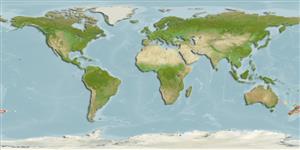Elasmobranchii (tubarões e raias) (sharks and rays) >
Carcharhiniformes (Ground sharks) >
Pentanchidae (Deepwater catsharks)
Etymology: Apristurus: a-, Latin privative, i.e., without; pristis, from pristes (Gr.), sawyer (but here meaning saw); oura (Gr.), tail, referring to absence of saw-toothed crest of enlarged dermal denticles along upper edge of caudal fin as found in the closely related Pristiurus (=Galeus). (See ETYFish); ampliceps: amplus (L.), large; ceps (New Latin), head, 21.8-25.5% TL). (See ETYFish).
Environment: milieu / climate zone / depth range / distribution range
Ecologia
marinhas batidemersal; intervalo de profundidade 800 - 1503 m (Ref. 76941). Temperate
Southwest Pacific: New Zealand and Australia.
Tamanho / Peso / Idade
Maturity: Lm ? range ? - ? cm
Max length : 85.5 cm TL macho/indeterminado; (Ref. 76941); 79.6 cm TL (female)
Descrição suscinta
Chaves de identificação | Morfologia | Morfometria
This species has the following characters: upper labial furrows about equal to, or slightly shorter than the lower ones; length of pre-outer nostril 4.5-6.6% TL; semicircular upper jaw; continuous supraorbital sensory canal; first dorsal fin is slightly smaller than second; anal fin is rounded in shape; narrow dermal denticles, leaf-like and sparse in distribution; enlarged dermal denticles absent along the dorsal margin of caudal fin; 8-11 spiral valves in intestine; size at maturity 65.0-75.0 cm TL; uniformly brown or blackish brown body and fins (Ref. 76941).
Claspers of males are short and less than 2.0% TL in specimens less than 52.7 cm TL, which is ranked as maturity stage 1 (immature); 73.3-76.5 cm TL have long but soft claspers (3.9-4.2% TL, maturity stage 2; greater than 78 cm TL have long, well developed and hardened
claspers (3.6-5.6% TL, maturity stage 3). Immature males are less than 52.7 cm TL and for females 37.4 cm TL (maturity stage 1); adolescent in males of 73.3-76.5 cm TL and females of 57.8-65.6 cm TL are (maturity stage 2); and adult in males with greater than 78 cm TL and females greater than 67.8 cm TL (maturity stage 3) (Ref. 76941).
Ciclo de vida ou comportamento de acasalamento
Maturities | Reprodução | Spawnings | Egg(s) | Fecundities | Larvas
Sasahara, R., K. Sato and K. Nakaya, 2008. A new species of deepwater catshark, Apristurus ampliceps sp. nov., (Chondrichthyes: Carcharhiniformes: Scyliorhinidae), from New Zealand and Australia. In Last, P.R., White, W.T. & Pogonoski, J.J. (eds.): Descriptions of New Australian Chondrichthyans. CSIRO Marine and Atmospheric Research Paper no. 22, pp. 93-104. (Ref. 76941)
Status na Lista Vermelha da UICN (Ref. 130435)
Ameaça para os humanos
Harmless
Uso pelos humanos
Ferramentas
Relatórios especiais
Baixar XML
Fontes da internet
Estimates based on models
Preferred temperature (Ref.
123201): 3.5 - 6.4, mean 4.6 °C (based on 20 cells).
Índice de diversidade filogenética (Ref.
82804): PD
50 = 0.5000 [Uniqueness, from 0.5 = low to 2.0 = high].
Bayesian length-weight: a=0.00355 (0.00176 - 0.00714), b=3.09 (2.91 - 3.27), in cm total length, based on LWR estimates for this (Sub)family-body shape (Ref.
93245).
Nível Trófico (Ref.
69278): 4.0 ±0.4 se; based on size and trophs of closest relatives
Resiliência (Ref.
120179): Muito baixo(a), tempo mínimo de duplicação da população maior que 14 anos (Fec assumed to be < 10).
Fishing Vulnerability (Ref.
59153): Moderate to high vulnerability (54 of 100).
